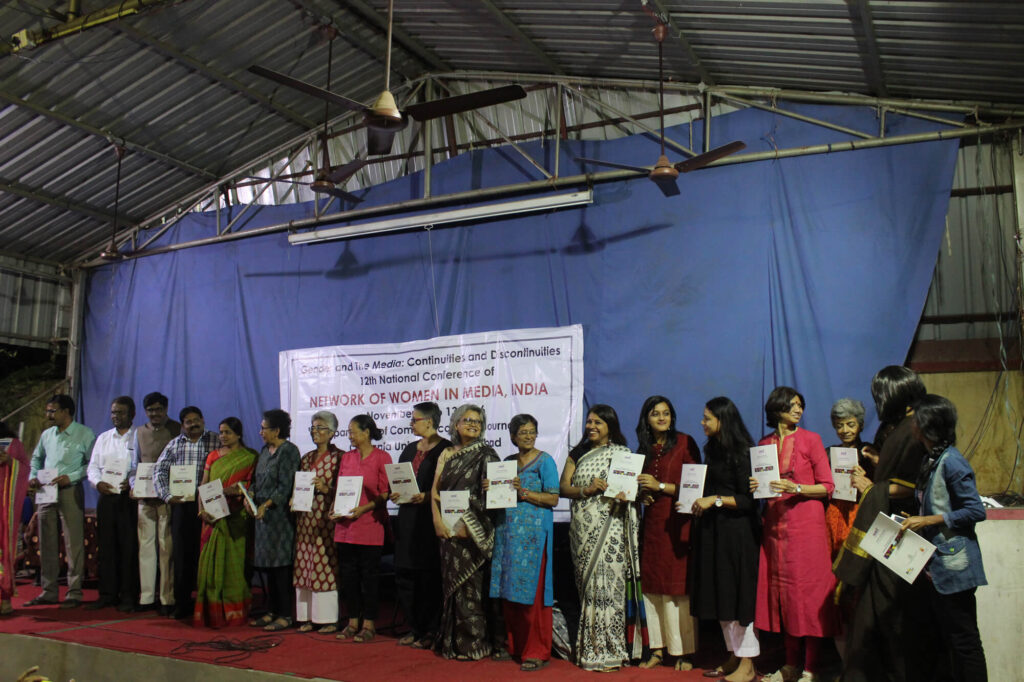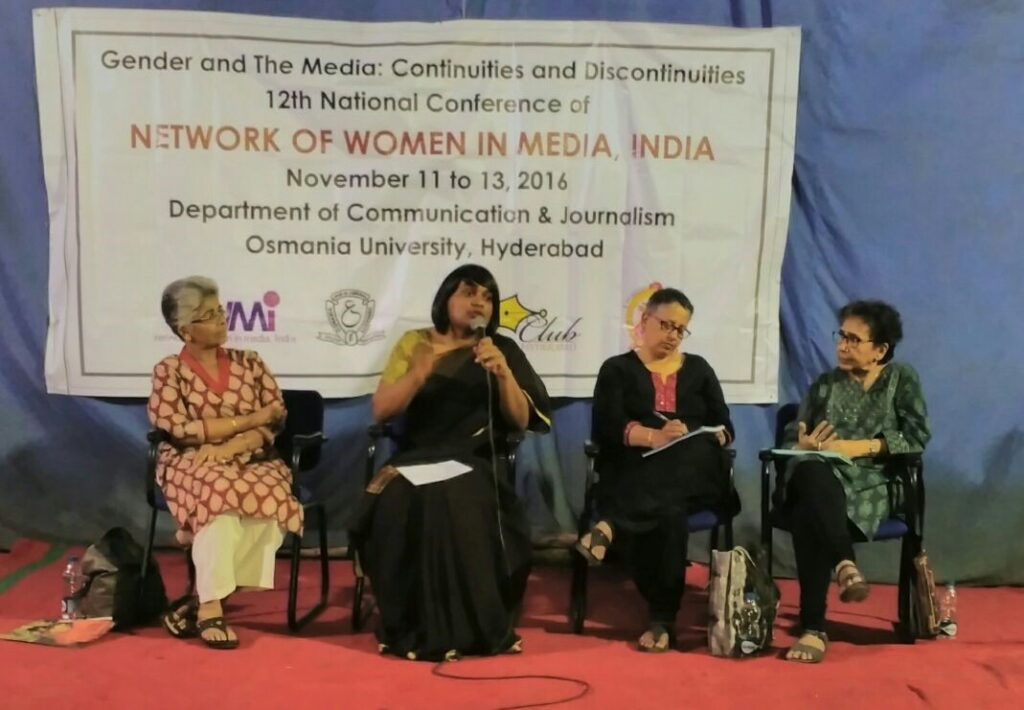Public session: Gender in Media: Continuities and Discontinuities
Two busloads of eager media women were welcomed at the Press Club, Khairatabad, with steaming hot tea, vadas and spicy chutney, warming up an evening that was just turning chill. Local journalists and other Hyderabadis streamed into the packed venue of the public meeting. After Rajamouli Chary, President of the Press Club, welcomed the participants, Vijay Kumar, Secretary Press Club, Prof Sathi Reddy, Professor of Journalism and Registrar of Telugu University, and Prof K Stevenson, Head of the Mass Communication and Journalism department at Osmania University, made brief speeches. Together with members of the network they then formally released the Souvenir published by the NWMI Hyderabad chapter.

Ammu Joseph, a founder member of the network and a Bangalore-based independent journalist, chaired the public meeting and set the tone with her introduction to the NWMI, reminding the gathering that the network had held its third national meeting in the city 11 years earlier. Drawing on nostalgia, but offering a glimpse into the ephemeral yet substantive nature of the network, she likened it to the irrepressible, passionate and will-o-the wisp-like Maria from the all-time favourite musical, The Sound of Music. “It is tough to explain how a voluntary, informal, non-hierarchical, participatory collective that has no institutional affiliation, infrastructure, staff or money exists, let alone how it has not only survived for 14 years but continues to grow and thrive,” said Ammu.
She also likened the network to a cloud, “Especially now that the word is often used as a metaphor for the Internet. Much of the time it is a virtual network, with our interactions taking place in our Yahoo, Facebook and WhatsApp groups. That’s why these periodic national meetings are so precious, giving us an opportunity to cross the physical distance between us, meet face to face, and continue our online conversations in real time and space. How important this is to many of us is evident from the fact that we not only take time off from our busy schedules but free ourselves of professional and personal preoccupations to travel cross-country, paying our own way, contributing a modest registration fee, for the pleasure of spending time with each other, sharing experiences and views, learning from each other and invited speakers, and participating in actual debates.”
Ammu pointed out that since the network has no funding per se, a major task that local organisers take on is seeking support in cash or kind for the specific purpose of the meeting. Highlighting the fact that institutions in Hyderabad – media organisations in the past and universities (Osmania University and Telugu University) this time – have been particularly supportive, she said, “I would like to take this opportunity to appreciate the relationships our members here evidently have with these institutions and, of course, the generosity of our local sponsors.”
Kalpana Sharma, senior journalist now retired from The Hindu and a founding member of the network, reflected on the tumultuous times and changing concerns that characterise the media today. “This has been a week we will not forget,” she began. “On November 8, even as America woke up to vote, Indians heard their prime minister announce that, within four hours, all 1,000 and 500 rupee notes would be nothing more than pieces of paper. By the time November 9 dawned in India, Americans had defied all predictions of polls and the media and voted in Donald Trump. And Indians woke up to face a day without any cash.”
She highlighted the need to go back to the basics of journalism: “The discussion about what the media missed in the US has considerable relevance for us in India. It shows us how easily we as journalists can get out of touch with reality if we rely on technology and punditry instead of the traditional ways of reporting.” According to Kalpana, who was editor of the fiercely independent weekly Himmat during the Emergency in India (1975-77), “It is important to recognise that Emergency-like situations can happen suddenly, as in 1975. But they can also creep up on you, as now. When the freedoms we take for granted are slowly and steadily whittled, we don’t realise that we are operating under another kind of censorship, one that is more insidious than the direct censorship we experienced during the Emergency.”
Kalpana cautioned that the media was going to witness more direct and indirect pressure if journalists dared to expose the ruling party and the government. In addition, media economics will increasingly make independent media vulnerable while there will be greater consolidation and concentration of corporate media. Yet, as she pointed out, the good news was that “There are new and younger journalists willing to take on and buck the system, some of them in this audience; there are digital platforms providing space for these stories. The reach of digital and the alternative platforms on it will grow in the years to come.”

Talking about the threats from within, Laxmi Murthy, consulting editor with Himal Southasian and also a founding member of the network, drew attention to the ubiquitous phenomenon of sexual harassment in the media. She referred to a recent study by the International Federation of Journalists, Inside the News: Challenges and Aspirations of Women Journalists in the Asia Pacific, to which a few NWMI members had contributed. The study revealed that a quarter of the women surveyed said that they had witnessed or heard about sexual harassment at their workplace. In contrast, only 10 percent of the men surveyed reported having witnessed or heard about sexual harassment. With 90 percent of men oblivious to sexual harassment at the workplace, the continued invisibilisation of such rampant violence against women at the workplace was a cause for concern, especially when only a few media houses have put in place the complaints and redress mechanisms mandated by law.
While some cases of sexual harassment, such as the ‘Tehelka case’ and the case in Sun TV, have been discussed in the media and other public forums, most women journalists face sexual harassment almost as a part of the job, and this is hardly spoken about. According to Laxmi, what is required is a change in the culture of newsrooms so that the gender of a media worker should not matter, and the professional space enables creativity and intellectual growth among all employees. In fact, she stressed, making newsrooms conducive for women journalists by tackling practices that make them hostile workspaces is an equal opportunities issue.
Laxmi addressed the widespread anxiety about the law against sexual harassment being ‘misused’, pointing out that there is not enough evidence to suggest misuse at a time when there is little data even on its use. She suggested approaching the issue from the viewpoint of civil remedy, where the intention is not to be punitive, but to proactively create a workplace atmosphere in which women can realise their full potential. Alongside pressure to implement the law must come awareness raising among both men and women employees, and discussions on the issue in open forums such as the present one.
Transgender activist Vyjayanti Vasanta Mogli, founder of the Telangana Hijra Intersex Transgender Samiti, in her incisive and heartfelt presentation, focussed on media representations of the transgender body. She confined her critique to the English ‘mainstream’ print and online media which, by and large, tend to invisibilise the lived reality of transgender women. Headlines such as ‘Trapped in the wrong body’ feed into the gender binary, she pointed out.
According to her, the recent Supreme Court judgement in the National Legal Services Authority v. Union of India, also known as the NALSA case, was extremely far-sighted in this regard, since it conceptualised gender identity as emanating from the brain and not the genitals. The principle of self-determination of gender is a crucial one, and the judgement, despite some flaws, recognises this notion, she said. The NALSA judgement has brought some relief to the community, but not all states have implemented it. Vyjayanti pointed out that the media has not adequately highlighted this lack of implementation. Nor has it called out discrimination against transgender people in educational institutions and workplaces. Structural violence, due to which transgender people are pushed to the margins of society, has resulted in their constructing their own communities, cultures and means of livelihood.
There is also a lack of awareness in the media about the complexities of the legal issues surrounding gender identity. For example, the draconian Rights of Transgender Persons Bill has taken a few steps back from the progressive Supreme Court judgement in the NALSA case, conflating biological sex with gender and thereby eliminating 95 percent of transgender people from its definition. The humiliation involved in being ‘certified’ as transgender, as proposed in the proposed Bill, has also not come under the media scanner. Likewise, the atrocities on transwomen – most recently Tara, burnt to death in front of a police station in Chennai – have not received the media attention they deserve.
After the thought-provoking discussions, participants headed to a sumptuous dinner of signature Hyderabadi biryani, hot pakodas, sabudana vadas, ginger and chilly chicken and enjoyed unwinding among old friends and new.


